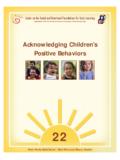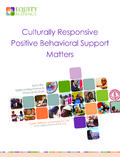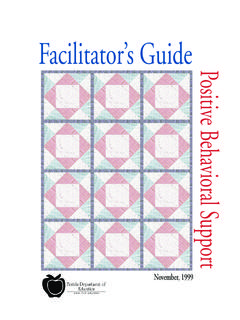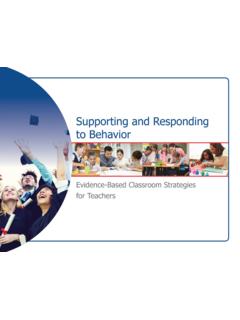Transcription of School-wide Positive Behavior Support (SWPBS)
1 What is School-wide Positive Behavior Support ? School-wide Positive Behavior Support (SWPBS) SWPBS is a systematic approach for implementing proactive School-wide discipline and is currently being implemented in over 7,000 schools in over 37 states. The purpose of SWPBS is to improve school climate and prevent student problem behaviors across all school settings. Essential elements of SWPBS include: (1) building a culture within the whole school that will serve as a foundation for both social and academic success, (2) emphasizing early identi-fication and prevention of problem Behavior , (3) directly teaching appropriate social skills to all students, and modifying or rearranging the school context when necessary to prevent problem Behavior , (4) using a three-tiered continuum of Behavior Support practices in order to prevent problem Behavior , and (5)
2 Ac-tively using data for decision-making. SWPBS focuses on achieving social and academic achievement outcomes by establishing data, systems, and practices. All students receive the Support they need for success based on a continuum of need and intensity. The goal of Tier 1 or Primary Prevention is to create a Positive school culture in which pro-social student behaviors are taught and reinforced, and all adults respond to the occurrence of problem Behavior in a consistent manner.
3 In SWPBS, Tier 1 strategies are designed using evidence-based practices. All fac-ulty members work together to improve academic and behavioral outcomes for all students. Tier 2 or Secondary Prevention is intended to Support students who have learning, Behavior , or life histories that put them at risk of engaging in more serious problem Behavior . Tier 3 or Tertiary Prevention strategies are used to Support the smaller number of students whose needs are more individualized than strategies imple-mented at Tier 1 or Tier 2.
4 At the national level, response to instruction or response to intervention (RtI) is used to describe a three-tiered prevention approach for both academics and Behavior . Publications, websites, and presenta-tions often refer to RtI for Behavior using terms such as effective Behavior Support (EBS), program- wide Positive Behavior Support (continued on next page) Inside this issue: Importance of a District- wide Model 2 SWPBS Implementation 2 How SWPBS is Different 3 Evaluating the Effectiveness of SWPBS 4 Featured Case Study: Westridge Middle school 6 Short Story: Hocker Grove Middle school 8 Short Story: Salina Central High school 10 Expectations.
5 Jefferson Elementary 11 Kansas Institute for Positive Behavior Support at the University of Kansas March, 2009 Volume 1, Issue 1 Figure 1. The SWPBS Three-Tiered Model. What is School-wide Positive Behavior Support ? (Continued from Page 1) Page 2 School-wide Positive Behavior Support (SWPBS) (in early childhood settings), Positive behavioral interventions and supports (PBIS), Positive Behavior Support (PBS), and School-wide Positive Behavior Support (SWPBS). It is also common to see multiple terms for the same interventions at each tier of the triangle.
6 However, RtI can differ greatly based on the underlying vision for prevention, the types of implementa-tion efforts used, the way in which training is provided, and the systems change efforts that form the founda-tion for districts and schools implementing RtI. Therefore, it is important to understand the essential features of RtI when evaluating implementation efforts that are reported to be based on a three-tiered prevention model. Why Is a District- wide Model so Important? Although schools can implement SWPBS independently without district Support , it is more difficult to establish effective and sustainable implementation without some guidance from professionals who have had experience in both content related to applied Behavior analysis and/or Positive Behavior Support and systems change efforts at all three implementation levels.
7 New initiatives, resources for implementation, and profes-sional development opportunities all have an impact on the school leadership team s ability to implement SWPBS. Districts implementing SWPBS create an infrastructure for supporting data collection, design policies and procedures that Support SWPBS, provide training for staff, and assist teams by allocating planning time and resources. District Support is essential for teams implementing Tier 3 supports, especially when resources for professional development are tight and behavioral expertise is not widely available.
8 Visit the website, ~nirn/resources/publications/Monograph/, for research related to effective implemen-tation. SWPBS Implementation It is important to note summaries of SWPBS imple-mentation mentioned in this newsletter do not reflect all dis-tricts and schools implementing SWPBS in Kansas. There are a number of districts and schools implementing SWPBS with Support from other trainers across the state. The purpose of this newsletter is to share progress made in SWPBS supported by the Kansas Institute for Positive Behavior Support .
9 Currently, the University of Kansas has been working with seven districts and 48 schools participating in the state- funded SWPBS training. As you can see from Figure 2 and Figure 3 on the next page, the number of districts and schools implementing SWPBS is growing each year. Each district participating in the state s SWPBS efforts began the imple-mentation process by creating a district leadership team. Dis-trict leadership teams include representatives of all stake-holders within a district and are (continued on next page) Figure 2.
10 Number of districts implementing SWPBS. responsible for conducting a self assessment, creating a vision and three-year action plan for implementing SWPBS, and supporting schools implementing SWPBS within the district. In addition, each district leadership team has identified a dis-trict coordinator who facilitates district leadership team meet-ings, coordinates trainings, and summarizes the data collected for evaluation purposes. Each school participating in SWPBS forms a planning team including representatives from the entire school , stu-dents, family members, and other community collaboration.









